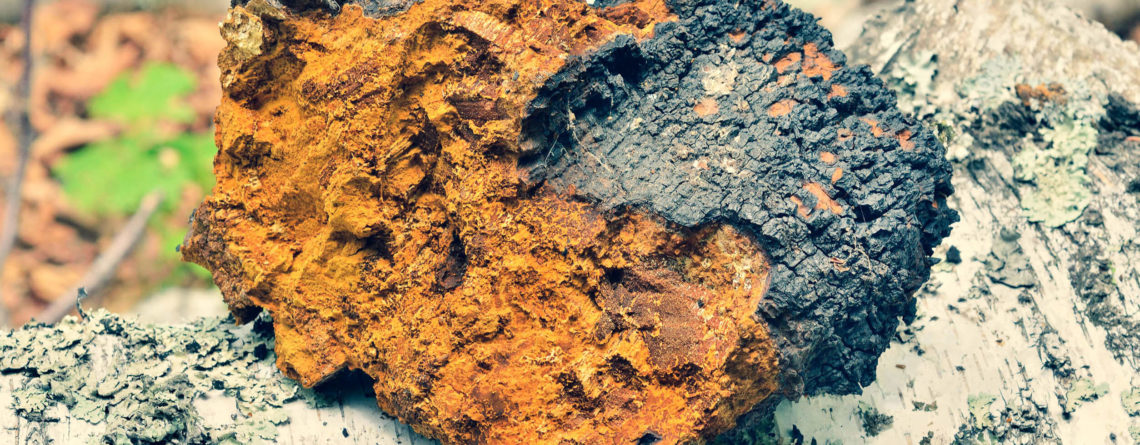How to process and store chaga

So, you brought the chaga home, and it needs to be processed and put away for storage. If you have not cleaned the chaga from the black crust in the forest, you will have to do it at home. Take a heavy knife or a hatchet and go ahead. There are few medicinal substances in the crust of the chaga – it is practically pure chitin, which has been subjected to the same long-term weathering and washing by rains. Therefore, the crust can be safely thrown away, unless you want to use its antiviral properties. But the chaga crust has more than enough of these qualities: according to the results of recent studies, its antiviral activity is the highest among fungi. For example, the influenza A and B viruses are 100% killed by the crust. Therefore, the chaga crust is an excellent prevention of viral diseases, it increases the nonspecific immunity of the body.
To keep the chaga for a long time and not moldy, you need to dry it. Drying is a mandatory first stage for all types of processing. There is no need for it, only if you have gained quite a bit of chaga, and decided to immediately use it entirely for making tea, double extract or all kinds of infusions and tinctures. Then you need to chop the raw chaga into fragments of the size specified in the recipes.
The most gentle way of drying the chaga is traditionally considered to be drying in the sun. If the weather is good, or you live closer to the forest-steppe, and not in our damp places, chop the chaga into pieces 3-5 cm and take it out for several days in a row under the bright sun, placing the pieces in one layer. At night, the chaga should be brought into a dry room to avoid dampening.
Most often, the chaga is dried, chopped into medium-sized pieces (3-10 cm). The normal drying temperature is from 40 to 120 ° C; the higher it is, the faster the mushroom dries. Do not worry, even at a high drying temperature, chaga does not lose its medicinal properties, although in Russian tradition it is believed that the temperature should be 35-60 ° C (we are afraid to cook chaga in boiling water, although this is also a misconception). A good final humidity is considered 10-14%.
If you have a lot of space, it is best to store chaga in large and medium pieces. If there are not very many places, then they are usually divided into smaller ones – so the chaga fits more compactly. In order to avoid littering, injury and destruction, the most accurate way is to wrap a piece of chaga with a cloth, and then beat it with a hammer or a stone. I do not recommend grinding chaga for storage, especially for a long time, into powder – in powder, chaga loses its properties much faster. It is better to store it in pieces, even small ones, and grind it (if you need powder) as needed. In general, this approach works for any dried mushrooms.
It has been noticed that dried chaga, which has not had the black crust removed, is stored better and longer completely cleaned. Moreover, the larger such crusted pieces are, the longer the quality of the product is preserved. If you can afford to peel the chaga before cooking it every time, then this method is good for you.
Fully dried pieces of chaga are best stored in an airtight glass container or a glass jar with a screw cap. If you are lucky enough to live in a house or apartment with a low humidity level, you can simply put them in a wooden basket or unclosed paper or fabric bags. According to Russian folklore, it is necessary to store dried pieces of chaga only in a birch bark box in order to strengthen the subtle energy of the chaga, which reacts to the “mother” tree. The normal storage time for chaga is two years. A small amount of chaga can be stored indefinitely for a long time without loss of quality by placing it in an airtight container or a ziplock bag in the freezer.
It is necessary to use the chaga as necessary, selecting from the stored batch exactly the amount that is required to complete the current task. It is not so difficult to grind a daily portion of chaga for brewing, but if you are lazy, you can grind the powder for a week. It should also be stored in an airtight glass container.
If mold has started to develop on the pieces of chaga, it means that the tightness of storage is broken, or humidity has increased in the room, or the chaga was not dried initially. Moldy chaga should be thrown away, and not try to dry or “save” the inner “clean” layers.
More about mushrooms on the website Mikhail Vishnevsky
